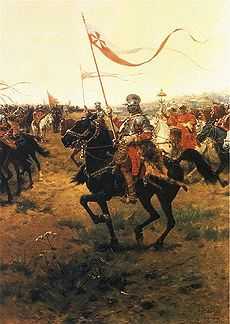Towarzysz

A Towarzysz ("Companion", plural: towarzysze) was sort of a junior cavalry officer or rather knight-officer in the autorament narodowy Polish-Lithuanian Commonwealth National army, both in cavalry and infantry, from the 16th century until 1794 AD.
In the Polish-Lithuanian Commonwealth's National army (until the 1775 AD reforms) towarzysz was usually a noble who served for a period of time (usually less than 5 years) in the Army as a horseman with his mounted retainers (cavalry) and free servants (hussars, cossack – pancerny, petyhorcy, haiduk), or with none or one retainer and very few free servants (light cavalry e.g. Wallachian, lisowczyk, Tatar), organized into banners/companies (chorągiew). His pay was relative to the type of cavalry unit he served, whether in (hussars, cossack – pancerny), banners. He usually brought between 1 to 4 men (pocztowy or pacholiks) with him in his "retinue" (poczet) prescribed by his current military contract with his commander, the rotameister (rotmistrz), and the state. He armed, provisioned and commanded his retainers, and his free servants, that provided care for horses and weapons, forage, set up camp, and mended equipment. In the light cavalry, a towarzysz usually fought with a very small poczet.
They were differentiated based on their horse unit origin, depending on whether they joined a heavy cavalry unit – (Towarzysz husarski of the Polish hussars), a medium cavalry banner – towarzysz kozacki (name change after 1648 AD – Towarzysz pancerny), a light cavalry banner – towarzysz lekkiego znaku etc. The richest and most prestigious were towarzysze that came from the winged hussar banners, but their own expenses' burden was the most excessive and grew as the 17th century progressed. After 1775 reforms that modernized Polish-Lithuanian cavalry towarzysz was usually a lancer and a head of the smallest unit in the Kawaleria Narodowa, Pulk Jazdy Przedniej or other various guard cavalry regiments of the Commonwealth.
Curiosities
In Austrian empire, after the Second Partition of Poland, in 1781 a Polish-style cavalry regiment under the name Königliche galizische adelige Leibgarde was organized, preserving the Towarzysz-pocztowy unit organization. In Russia, after the Third Partition of Poland in 1797, two Polish-based cavalry regiments were organized: Konnopolski Regiment and Tatar Regiment along the lines of towarzysz-pocztowy organization. In the Prussian army under Frederic William II of Prussia and his successor there were several cavalry regiments organized along the lines of Polish towarzysz cavalry from the Polish and Polish Tatar nationals under the Prussian rule, and one cavalry regiment was actually called Towarczys Regiment, organized in 1799. The regiment retained towarzysz and retainers structure and a Polish uhlan lance as primary weapon, but this regiment did not survive Prussian collapse of 1806, where most men went, along with their horses and weapons into Polish service. However other Polish-based regiments were converted to Uhlan regiments in 1807 and formed basis for Prussian uhlan regiments until the end of Prussia.
During the 19th century Towarzysz assumed the same meaning as the Russian communist товарищ (tovarishch), or 'comrade' in English language, and as such was used in the 20th century and today.
References
- Richard Brzezinski, Polish Armies:1569–1699,London 1987. vol. 1, pp. 12–19.
- Richard Brzezinski, Polish Winged Hussar, New York 2006, pp. 8–10.
- Konstanty Górski, Historia Jazdy Polskiej, Kraków 1894.
- Peter Hofschröer, Prussian cavalry of the Napoleonic Wars, Volume 1, London 1985.
- Radosław Sikora, Wojskowość polska w dobie wojny polsko-szwedzkiej 1626–1629. Kryzys mocarstwa, Poznań, 2005, s. 76–77;
- Jan Wimmer. Wojsko Polskie w drugiej polowie XVII wieku, Wojskowy Instytut Historyczny, Wydawnictwo Ministerstwa Obrony Narodowej, Warszawa 1965,
- Zygmunt Gloger, Encyklopedia starapolska ilustrowana, Volume 4, Warszawa 1903 pp. 379–380.
See also
- Comrade
- Poczet
- Pocztowy
- Towarzysz husarski
- Towarzysz pancerny
- Offices in Polish-Lithuanian Commonwealth